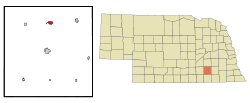2010 census
As of the census [13] of 2010, there were 560 people, 243 households, and 151 families residing in the village. The population density was 682.9 inhabitants per square mile (263.7/km2). There were 299 housing units at an average density of 364.6 per square mile (140.8/km2). The racial makeup of the village was 97.7% White, 0.5% Native American, 0.2% Asian, 1.4% from other races, and 0.2% from two or more races. Hispanic or Latino of any race were 2.3% of the population.
There were 243 households, of which 24.7% had children under the age of 18 living with them, 49.0% were married couples living together, 8.6% had a female householder with no husband present, 4.5% had a male householder with no wife present, and 37.9% were non-families. 33.3% of all households were made up of individuals, and 17.7% had someone living alone who was 65 years of age or older. The average household size was 2.14 and the average family size was 2.68.
The median age in the village was 50.1 years. 18.6% of residents were under the age of 18; 5% were between the ages of 18 and 24; 18.1% were from 25 to 44; 31.2% were from 45 to 64; and 27% were 65 years of age or older. The gender makeup of the village was 48.2% male and 51.8% female.
2000 census
As of the census [4] of 2000, there were 691 people, 275 households, and 171 families residing in the village. The population density was 996.2 inhabitants per square mile (384.6/km2). There were 309 housing units at an average density of 445.5 per square mile (172.0/km2). The racial makeup of the village was 95.80% White, 0.14% African American, 0.72% Native American, 0.14% Asian, 1.45% from other races, and 1.74% from two or more races. Hispanic or Latino of any race were 3.04% of the population.
There were 275 households, out of which 30.2% had children under the age of 18 living with them, 53.1% were married couples living together, 6.9% had a female householder with no husband present, and 37.8% were non-families. 33.8% of all households were made up of individuals, and 21.1% had someone living alone who was 65 years of age or older. The average household size was 2.35 and the average family size was 3.02.
In the village, the population was spread out, with 25.8% under the age of 18, 4.3% from 18 to 24, 23.6% from 25 to 44, 23.0% from 45 to 64, and 23.3% who were 65 years of age or older. The median age was 42 years. For every 100 females, there were 82.3 males. For every 100 females age 18 and over, there were 79.4 males.
As of 2000 the median income for a household in the village was $35,658, and the median income for a family was $41,618. Males had a median income of $31,667 versus $18,125 for females. The per capita income for the village was $15,957. About 8.0% of families and 12.6% of the population were below the poverty line, including 13.8% of those under age 18 and 24.8% of those age 65 or over.


